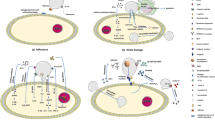Abstract
Acute invasive fungal rhinosinusitis (AIFRS) is a rapidly progressive life threatening infection that is seen most commonly among immunocompromised patients. We present a case series of 18 patients clinically and histopathologically diagnosed with AIFRS with a mean follow-up of 9.11 ± 2.51 months (range 6–17). Demographic data, apparent symptoms and signs, underlying disorders, and outcomes are discussed. The mean age was 39.56 ± 20.66 years (range 2–75). The most common underlying diseases were diabetes mellitus (50 %) and leukemia (44.44 %). Mucosal biopsy confirmed fungal invasion of the nasal mucosa in all cases. The main fungi were Rhizopus oryzae (55.56 %), Absidia mucor (16.67 %), and Aspergillus fumigatus (27.78 %). Headache and facial pain (77.8 %), facial paresthesia (55.6 %), and ophthalmoplegia (33.3 %) were the most common symptoms and signs. Computed tomography and endoscopic findings showed various stages of sinonasal (100 %), pterygopalatine fossa (55.56 %), orbital (44.45 %), and cerebral (5.56 %) involvement. All patients underwent serial surgical debridement (3.78 ± 1.80 times; range 2–8) simultaneously with systemic antifungal therapy and proper management of the underlying disease. The most extreme case with brain involvement survived and recovered with no evidence of recurrent disease following treatment. All patients were considered cured after two endoscopic negative histopathologic evaluations. Three patients (16.67 %) died, one from uncontrolled leukemia and two due to renal failure. AIFRS is a potentially fatal condition, however, early diagnosis and management of the underlying disease accompanied with systemic antifungal and aggressive serial surgical intervention appears to be effective in reducing mortality in most patients.




Similar content being viewed by others
References
Momeni AK, Roberts CC, Chew FS (2007) Imaging of chronic and exotic sinonasal disease: review. AJR Am J Roentgenol 189(6):S35–S45
Aribandi M, McCoy VA, Bazan C (2007) Imaging features of invasive and noninvasive fungal sinusitis: a review. Radiographics 27(5):1283–1296
Gillespie MB, O’Malley BW, Francis HW (1998) An approach to fulminant invasive fungal rhinosinusitis in the immunocompromised host. Arch Otolaryngol Head Neck Surg 124(5):520–526
Parikh SL, Venkatraman G, DelGaudio JM (2004) Invasive fungal sinusitis: a 15-year review from a single institution. Am J Rhinol 18(2):75–81
Abu El-Naaj I, Leiser Y, Wolff A, Peled M (2013) The surgical management of rhinocerebral mucormycosis. J Craniomaxillofac Surg 41(4):291–295
Kursun E, Turunc T, Demiroglu YZ, Alışkan HE, Arslan AH (2015) Evaluation of 28 cases of mucormycosis. Mycoses 58(2):82–87
Ketenci I, Unlü Y, Kaya H, Somdaş MA, Kontaş O, Oztürk M, Vural A (2011) Rhinocerebral mucormycosis: experience in 14 patients. J Laryngol Otol. 125(8):16
Turner JH, Soudry E, Nayak JV, Hwang PH (2013) Survival outcomes in acute invasive fungal sinusitis: a systematic review and quantitative synthesis of published evidence. Laryngoscope 123(5):1112–1118
Saedi B, Sadeghi M, Seilani P (2011) Endoscopic management of rhinocerebral mucormycosis with topical and intravenous amphotericin B. J Laryngol Otol 125(8):807–810
Bellazreg F, Hattab Z, Meksi S, Mansouri S, Hachfi W, Kaabia N, Ben Said M, Letaief A (2014) Outcome of mucormycosis after treatment: report of five cases. New Microbes New Infect 6:49–52
Vaezi A, Moazeni M, Rahimi MT, de Hoog S, Badali H (2016) Mucormycosis in Iran: a systematic review. Mycoses. doi:10.1111/myc.12474 (Epub ahead of print)
Kermani W, Bouttay R, Belcadhi M, Zaghouani H, Ben Ali M, Abdelkéfi M (2016) ENT mucormycosis. Report of 4 cases. Eur Ann Otorhinolaryngol Head Neck Dis 133(2):83–86. doi:10.1016/j.anorl.2015.08.027 (Epub 2015 Sep 7)
Mohammadi R, Meidani M, Mostafavizadeh K, Iraj B, Hamedani P, Sayedain SM, Mokhtari M (2015) Case series of rhinocerebral mucormycosis occurring in diabetic patients. Caspian J Intern Med 6(4):243–246 (Fall)
Chen CY, Sheng WH, Cheng A, Chen YC, Tsay W, Tang JL, Huang SY, Chang SC, Tien HF (2011) Invasive fungal sinusitis in patients with hematological malignancy: 15 years experience in a single university hospital in Taiwan. BMC Infect Dis 22(11):250
Mohindra S, Mohindra S, Gupta R, Bakshi J, Gupta SK (2007) Rhinocerebral mucormycosis: the disease spectrum in 27 patients. Mycoses 50(4):290–296
Khor BS, Lee MH, Leu HS, Liu JW (2003) Rhinocerebral mucormycosis in Taiwan. J Microbiol Immunol Infect 36(4):266–269
Sun HY, Forrest G, Gupta KL, Aguado JM, Lortholary O, Julia MB, Safdar N, Patel R, Kusne S, Singh N (2010) Rhino-orbital-cerebral zygomycosis in solid organ transplant recipients. Transplantation 90(1):85–92
Kara IO, Tasova Y, Uguz A, Sahin B (2009) Mucormycosis-associated fungal infections in patients with haematologic malignancies. Int J Clin Pract 63(1):134–139
Bhadada S, Bhansali A, Reddy KS, Bhat RV, Khandelwal N, Gupta AK (2005) Rhino-orbital-cerebral mucormycosis in type 1 diabetes mellitus. Indian J Pediatr 72(8):671–674
Dhiwakar M, Thakar A, Bahadur S (2003) Improving outcomes in rhinocerebral mucormycosis—early diagnostic pointers and prognostic factors. J Laryngol Otol 117(11):861–865
Bhansali A, Bhadada S, Sharma A, Suresh V, Gupta A, Singh P, Chakarbarti A, Dash RJ (2004) Presentation and outcome of rhino-orbital-cerebral mucormycosis in patients with diabetes. Postgrad Med J 80(949):670–674
Author information
Authors and Affiliations
Corresponding author
Ethics declarations
Conflict of interest
None.
Rights and permissions
About this article
Cite this article
Bakhshaee, M., Bojdi, A., Allahyari, A. et al. Acute invasive fungal rhinosinusitis: our experience with 18 cases. Eur Arch Otorhinolaryngol 273, 4281–4287 (2016). https://doi.org/10.1007/s00405-016-4109-z
Received:
Accepted:
Published:
Issue Date:
DOI: https://doi.org/10.1007/s00405-016-4109-z



